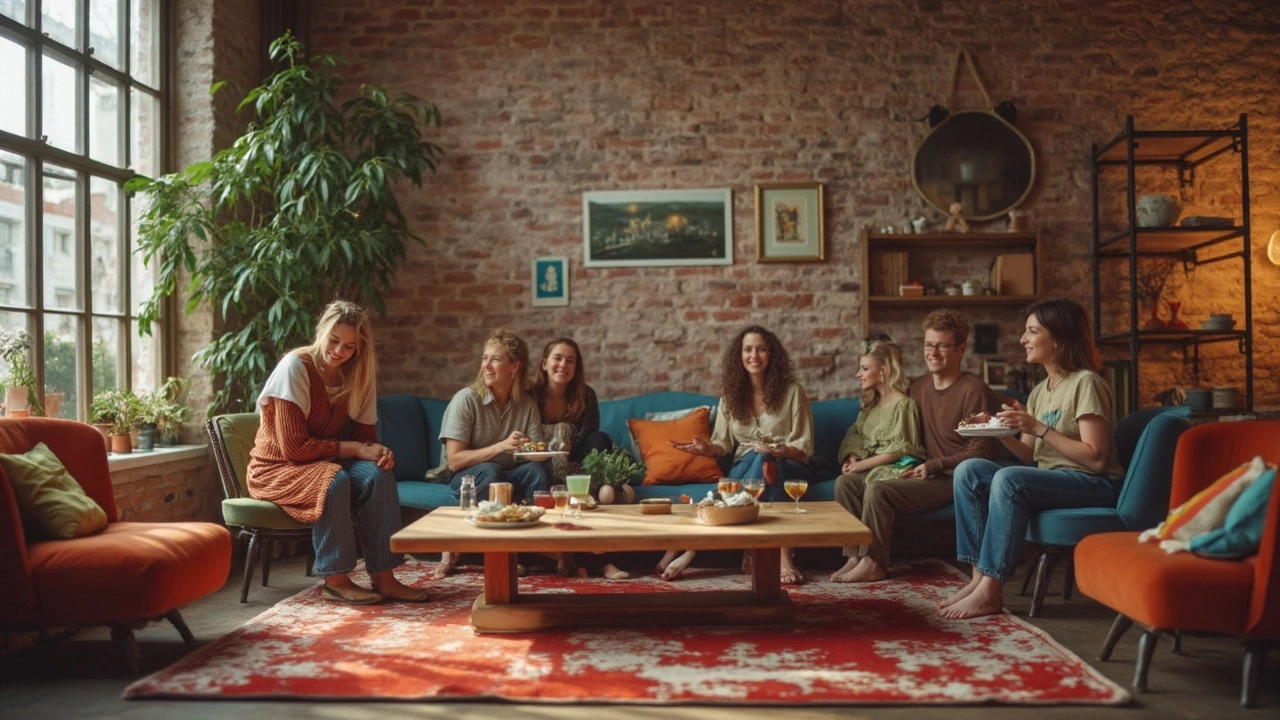If you’ve ever looked at your dining table and wondered why it’s mostly just holding piles of mail and not food, you’re not alone. Lately, more people are skipping the traditional dining table altogether, especially if space is tight or eating habits have changed.
City apartments aren’t exactly spacious, and let’s be honest—sometimes eating on the couch feels way more relaxed than sitting at a formal table. Takeout containers, Netflix, maybe your cat trying to steal a bite—who says you need a full setup to enjoy a meal?
The funny thing is, nobody’s really keeping score. There’s no rule that says a home isn’t complete without a dining table. What matters more is whether your space actually works for you. If you find yourself eating at the kitchen counter, on a barstool, or even off a coffee table, you’re doing just fine.
- Why We Think We Need a Dining Table
- How Modern Lifestyles Changed Mealtime
- Alternatives That Actually Work
- Tips for Making It Work Without One
- When a Dining Table Might Still Make Sense
Why We Think We Need a Dining Table
The idea that every home needs a dining table is something we’ve picked up over time, not because it’s written in stone somewhere, but mostly out of habit and tradition. Flip through any furniture catalog or Instagram post about home decor, and you’ll see at least one carefully set table ready for a magazine cover. It kind of feels like the default setting for a "real" home.
This goes way back. Historically, families ate together at a shared table for practical reasons—it was how food was served, divided, and enjoyed. In a lot of cultures, the dining table became the center of family life. It wasn’t just about eating; it was about having a place to gather, talk about the day, or host guests. For most people, that picture stuck.
Even now, some folks feel like skipping a dining table means missing out on something "proper." There’s this lingering sense that eating together around a table is good for bonding, and a 2023 Pew Research study actually found that families who share meals at a table—even just once or twice a week—are more likely to have open conversations. That’s a cool upside, but it also makes the table itself seem more important than it might really be.
Here’s the thing: the furniture industry naturally pushes the dining table as a must-have. It’s a big ticket item for stores, and plenty of home design guides make it look like a status symbol. And who hasn’t seen those fancy Pinterest setups with color-coordinated napkins and candles? Reality check—most people’s tables end up covered in keys, homework, or (if you’re like me) the occasional cat lounging right in the middle.
So yeah, the dining table has been hyped as a household staple, but that’s not the whole story. The real question is: does it actually fit your lifestyle, or is it just furniture you’re "supposed" to have?
How Modern Lifestyles Changed Mealtime
If you think back to family dinners from a few decades ago, having everyone at the dining table was pretty much expected. Fast forward to now, and life’s just not set up the same way. People are busier than ever. Work from home, side hustles, and packed schedules make sticking to a set dinner hour nearly impossible for most households.
More folks are eating at different times, grabbing food when it’s convenient. A recent survey showed that in the US, about 60% of meals are eaten alone—that’s a sharp jump from earlier generations. Grab-and-go eating has become the norm, especially in small city apartments and shared living spaces where a giant table isn’t practical.
Technology’s also a game changer. Streaming shows, gaming, or scrolling through your phone while eating has replaced the sit-down tradition. And honestly, who hasn’t had dinner with Netflix for company? Even kitchens are being designed differently, with more breakfast bars, kitchen islands, or even sofa trays built right in. It’s about finding what fits your lifestyle, not forcing everyone to the same spot every night.
Here’s a quick look at some modern mealtime habits:
- Flexible meal schedules—no set dinner time
- More solo dining thanks to tech and busy lives
- Meals happening in living rooms, offices, or even on the balcony
- Dining room furniture that does double duty—think fold-down tables or convertible counters
When your days are packed or your apartment is tiny, clinging to the classic dining table setup just isn’t a must anymore. It’s about what actually works for real life in 2025.

Alternatives That Actually Work
Just because you ditch the traditional dining table doesn’t mean mealtime has to be a mess. There are loads of smart setups that handle real-life eating, even if you’ve barely got room to swing a cat (no offense, Whiskers).
Breakfast bars or kitchen islands are game-changers, especially in smaller places. Lots of apartments and updated homes have these already. Pull up a stool, plug in your laptop, and you’ve got a quick spot for breakfast or dinner. Bonus: it keeps social stuff happening right where the food’s made.
Got a sturdy coffee table? That can totally fill in for formal dining room furniture. Coffee tables with storage underneath let you stash placemats, napkins, or your ever-growing takeout menu collection. Plus, eating in front of the TV is what Friday nights were made for.
Some folks swear by wall-mounted fold-down tables. These are lifesavers in small homes or studios. They flip out when you need them, disappear when you don’t. Ikea and other budget brands make versions that are easy to install and last for years. Check out this quick comparison:
| Alternative | Space Needed | Best For |
|---|---|---|
| Kitchen Island | Medium | Open kitchens |
| Coffee Table | Small | Studio/Living rooms |
| Fold-Down Table | Very Small | Tiny apartments |
Another easy fix: TV trays. Think old-school, but the new versions look decent and stash away fast. If you have company over now and then, pull out a tray or two. Problem solved.
If you eat out all the time or stick to quick bites, just make sure you have a clear spot somewhere—like a countertop or desk—where you can plug in and not spill on your stuff. What matters is having something that fits your daily habits, not just the old idea of what a dining table should be.
Tips for Making It Work Without One
Not having a dining table isn’t the end of good meals at home. There are actually a bunch of simple tricks to make eating without one work for your routines and your space.
- Create a go-to eating spot. Pick a steady place for meals, even if it’s your coffee table or a breakfast bar. This builds a habit so you aren’t juggling food all over the place.
- Use trays—seriously. Invest in a couple of sturdy trays. Eating on the couch? Trays keep spills off your cushions and make cleanup way faster. Plus, it’s handy for binge-watching and dinner at the same time.
- Foldable or stackable furniture rocks. Options like nesting tables or portable lap desks can save space but give you a flat surface when you need it. Fold them away when you’re done.
- Optimize what you’ve got. That kitchen counter you mostly use for dropping keys? Clear a section and add a couple of stools. Now it’s a decent place to eat, hang out, or do some work.
- Don’t forget comfy seating. If you eat where you relax, like on a couch, grab a supportive pillow and maybe a mini side table for drinks. It’s the little changes that make mealtime better without a dining table.
| Alternative Spot | How Many Can Eat Comfortably |
|---|---|
| Coffee Table | 2-3 |
| Counter/Bar | 1-4 |
| Lap Desks | 1 |
| Balcony Table (Small) | 1-2 |
It’s worth noting that over 25% of urban renters say they prefer multi-functional furniture, especially in studios and one-bedroom apartments. So, you’re definitely not the only one making flexible spaces work. Little shelves or baskets nearby for utensils, napkins, or condiments keep things neat, too.

When a Dining Table Might Still Make Sense
Sure, tossing your dining table sounds freeing, but sometimes it’s still the best move for your space and routine. Hosting friends or family for dinner? A dining table is hard to beat for serving up meals, playing board games, or just making enough space for everyone’s elbows and plates. Even if you live solo, a table can double as a work area, craft spot, or homework HQ for kids, making it one of the most flexible pieces of dining room furniture.
If you’re into home-cooked meals with more than two people, you’ll probably notice dinner goes smoother around a table. One 2023 survey found that families with a dedicated eating spot are twice as likely to eat together at least five nights a week. Meals around the table also tend to last longer—on average, 13 minutes longer than meals eaten on the couch, according to research on family eating habits.
Here’s what a dining table can help with:
- Hosting holiday meals, birthdays, or game nights.
- Creating a routine around shared eating—which has been linked to better mental health and stronger family bonds.
- Giving kids a steady spot for homework or art projects.
- Making meal prep and cleanup more organized, since everything’s in one spot.
If your home is the go-to spot for gatherings or you need an all-purpose surface, a table brings structure that a couch or coffee table just can’t match.
Stuck on the idea but tight on space? Plenty of city folks use extendable or drop-leaf options. Some even mount fold-down tables to the wall, so you can tuck them away once dinner’s done. Here’s a quick look at a few small-space solutions:
| Table Type | Seats | Best For |
|---|---|---|
| Drop-leaf | 2-4 | Tiny apartments |
| Extendable | 2-8 | Flexible needs |
| Wall-mounted fold-down | 2 | Single-person use or couples |
So if you’ve got people to gather, hobbies that need a flat surface, or just want a little more order, keeping a dining table in your setup is a solid call. Otherwise, don’t sweat it—make your space work for you.
